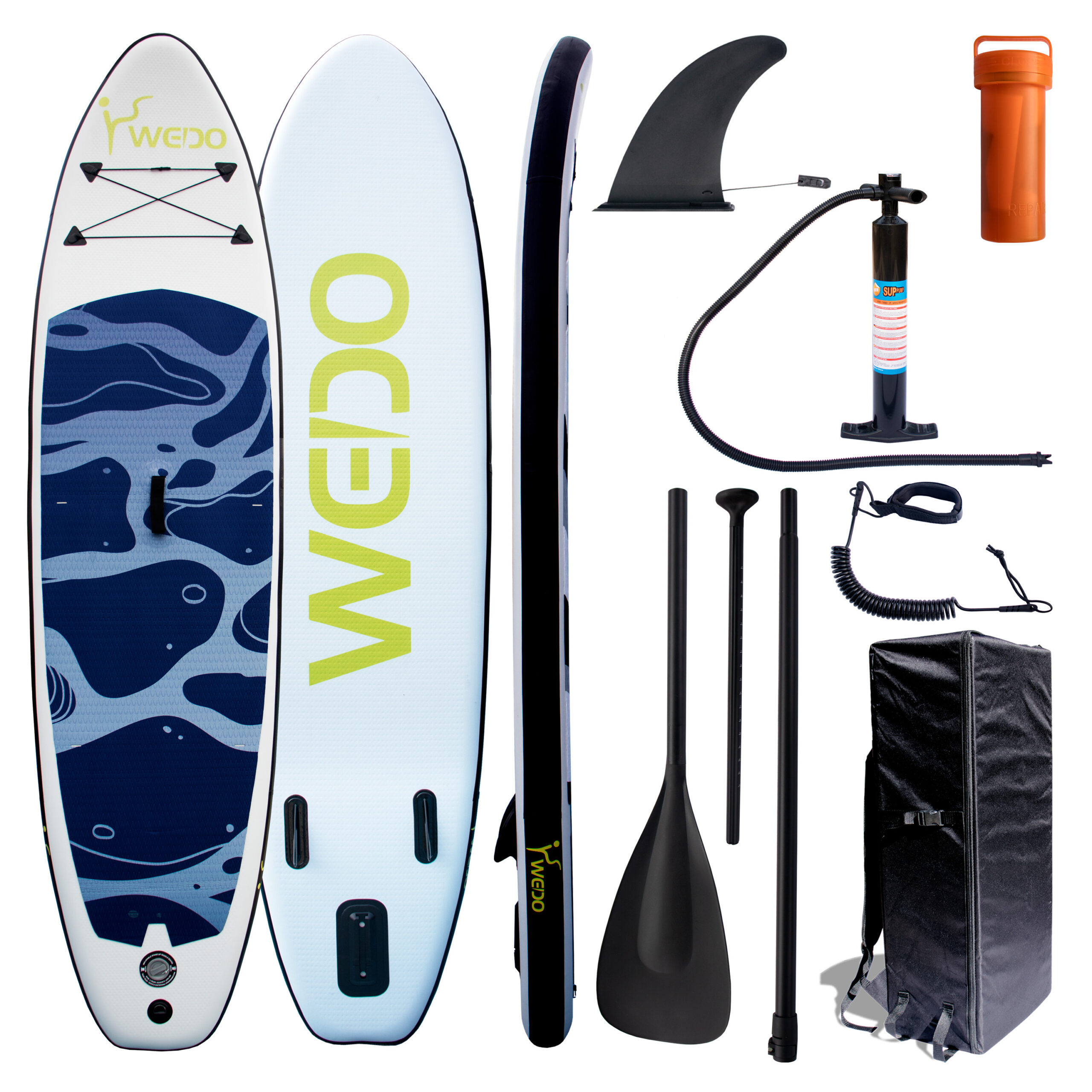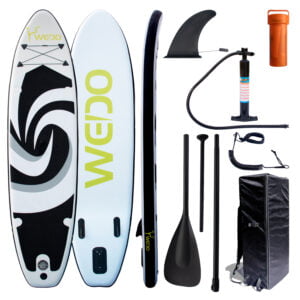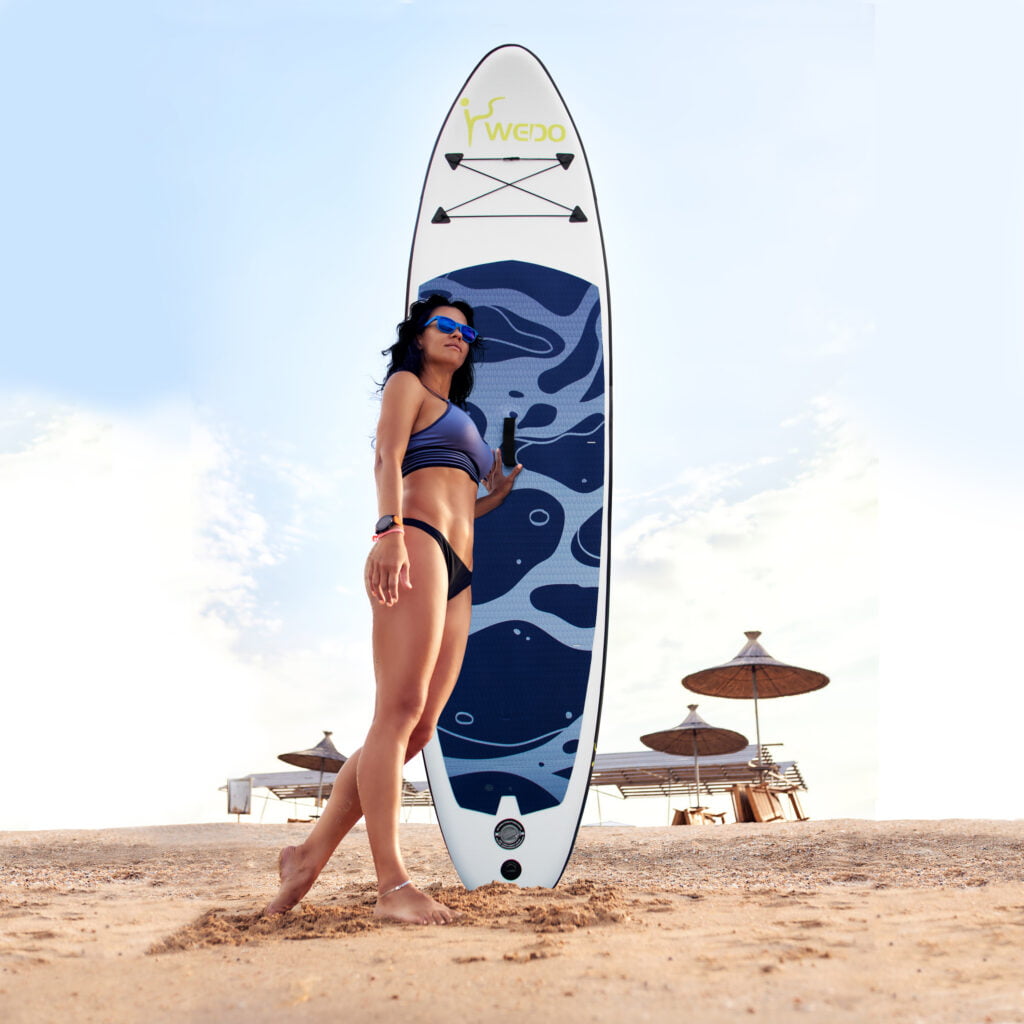Paddle surfboards, also known as stand-up paddleboards or paddleboards, are equipment used in the water sport called paddle surfing or stand-up paddleboarding (SUP). These boards are similar to traditional surfboards in shape and design, but are larger and are designed to be paddled while standing on them rather than lying down or sitting.
Common characteristics of paddle surfboards:
- Size: They are usually longer, wider and thicker than traditional surfboards, which provides greater stability and flotation.
- Material: They can be made of a variety of materials, such as foam, plastic, fibreglass, wood or inflatable. Inflatable boards are popular for their ease of transport and storage.
- Keel: Most paddle surfboards have one or more fins on the bottom to improve stability and steering.
- Carry handle: Many boards have a handle in the centre for easy transport to the water.

Paddle surfing is a versatile activity that can be done in calm waters, such as lakes, rivers and coastal waters, as well as in swell and surf conditions.
Paddle surfers use a long paddle to paddle while standing on the board, allowing them to move through the water and enjoy an exercise and recreational experience.
Moreover, paddle surfing is a growing sport that combines exercise, balance and contact with nature.
Differences between a paddle surf board and traditional surfing.
There are several key differences between a stand up paddle board (SUP) and a traditional surfboard:
- Size and shape:
- Paddle surfboards are considerably larger than traditional surfboards. They are generally longer, wider and thicker to provide greater stability and buoyancy, allowing surfers to stand upright on them.
- Traditional surfboards are shorter and designed for the surfer to lie or sit on. They are thinner and narrower to facilitate turning and performance in the waves.
- Use:
- Paddle surfboards are used for paddling while standing up. You can paddle in calm waters, lakes, rivers and oceans, as well as surfing in waves.
- Traditional surfboards are designed specifically for surfing waves and are mainly used in the ocean to glide over the waves.
- Pallets:
- In paddle surfing, a long paddle is used to paddle while standing on the board.
- In traditional surfing, surfers use their hands and bodies to paddle and propel themselves through the water before standing up on the board to surf the waves.
- Stability:
- Paddle surf boards are designed to offer greater stability and are ideal for beginners, as they allow you to maintain your balance while standing in the water.
- Traditional surfboards require good balance and more advanced surfing skills to stand up on them, as they are more unstable due to their narrow design.
- Sport and style:
- Paddle surfing is a versatile sport that combines exercise, relaxation and exploration in the water. It is suitable for a variety of water conditions and allows practitioners to enjoy scenery and activities on the water in a more relaxed way.
- Traditional surfing focuses on the thrilling challenge of riding waves and performing manoeuvres in surf conditions. It is best suited to those seeking the thrill and adrenaline of the waves.
- inflatables:
One of the common options for paddle surfboards is that they can be inflatable. This is a significant difference to traditional surfboards, which are usually made of rigid materials such as fibreglass or foam.
In short, paddle surfboards and traditional surfboards are different in size, shape, use and style. The choice between one or the other will depend on your personal preferences and your goals in the water.
Some key differences between inflatable and rigid paddle surfboards include:
- Portability and Storage: Inflatable boards are much easier to transport and store. They can be deflated and rolled up into a backpack or carry bag, making them ideal for people who don't have space to store a rigid board or who need to travel with their board.
- Durability: Inflatable boards tend to be more durable and resistant to shock and damage compared to rigid boards. This makes them an attractive option for paddle surfers in environments where they may encounter obstacles such as rocks or fast currents.
- Stability: Inflatable boards tend to be more stable due to their thickness and construction, making them ideal for beginners or those looking for greater stability in calm water.
- Cost: Inflatable boards are generally more affordable compared to rigid paddle boards.
However, rigid boards generally offer better performance in terms of glide and manoeuvrability in surf conditions. The choice between an inflatable and a hardboard will depend on your needs, preferences and the type of activities you plan to do in the water. Both types of boards have advantages and disadvantages, so it is important to consider your goals before making a decision.




